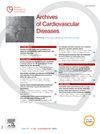Benefits of O-GlcNAcylation stimulation on cardiac output in hemorrhagic shock
IF 2.3
3区 医学
Q2 CARDIAC & CARDIOVASCULAR SYSTEMS
引用次数: 0
Abstract
Introduction
O-GlcNAcylation (O-GlcNAc) is a post-translational modification of cytoplasmic, nuclear and mitochondrial proteins that consists of the addition of a sugar, β-D-N-acetylglucosamine (or GlcNAc), to their serine and threonine residues. It is involved in many biological processes and appears to play an important role in the cell's response to stress and its survival.
Objective
The aim of this study was to evaluate whether stimulation of O-GlcNAcylation has a potential effect on hemodynamic parameters, during the early phase of hemorrhagic shock (HS), using NButGT an O-GlcNAcase inhibitor, to increase O-GlcNAc levels.
Method
Female large white pigs (35-42 kg) were subjected to a HS and trauma protocol induced via bilateral femur fractures and passively exsanguinated to 60% of their estimated total blood volume (ETBV) through the jugular catheter, and then randomly treated or not with NButGT (10 mg/kg). Other animals were retransfused with depleted blood (Whole blood group), and others were exposed only to anesthesia without trauma or bleeding (SHAM group). Invasive hemodynamic monitoring was performed using a pulse index continuous cardiac output (PiCCO) device. Blood samples were collected repeatedly as tissue samples after euthanasia. The time at which 40% of ETBV was drained was defined as the “T0” time. Treatment was injected a the end of exsanguination and 90 min after “T0”. The procedure was terminated 6 hours after “T0” (enthanasia of the animals).
Results
The proportion of animals who died prematurely without reaching the end of the procedure do not differ by group (P-value of χ2 > 0.05). Cardiac output was higher in the NButGT group compared with the placebo group, 90 min after “T0” (< 0.05), and also 120 min after “T0”, but without statistical significance (Fig. 1). Shock index was lower in the NButGT group compared with the placebo group, 90 min after “T0” (P-value < 0.05), and also 120 min after “T0”, but without statistical significance.
Conclusion
Our results show that NButGT administration could be helpful in minimizing the collapse of cardiac output and the rise in Shock Index in the acute phase of hemorrhagic shock. To our knowledge, this is the first time such results have been reported in a large mammal model. Further experiments will now be carried out, such as the study of O-GlcNAc levels by Western blot in heart cells, to confirm its increase under NButGT action and O-GlcNAc dynamics in this context.
o - glcn酰化刺激对失血性休克心输出量的益处
O-GlcNAc (O-GlcNAc)是细胞质、细胞核和线粒体蛋白质的翻译后修饰,包括在其丝氨酸和苏氨酸残基上添加糖β- d - n -乙酰氨基葡萄糖(或GlcNAc)。它参与了许多生物过程,似乎在细胞对压力的反应和生存中起着重要作用。目的本研究的目的是评估在失血性休克(HS)早期,使用NButGT (O-GlcNAcase抑制剂)刺激o - glcnac酰化是否对血流动力学参数有潜在影响,以提高O-GlcNAc水平。方法对35 ~ 42 kg的雌性大白猪进行双侧股骨骨折致HS和外伤治疗,经颈静脉导管被动放血至估计总血容量(ETBV)的60%,然后随机给予NButGT (10 mg/kg)。其他动物用耗尽的血液再输注(全血组),其他动物只暴露于麻醉,无创伤或出血(SHAM组)。采用脉搏指数连续心输出量(PiCCO)装置进行有创血流动力学监测。在安乐死后反复采集血液样本作为组织样本。排出40% ETBV的时间被定义为“T0”时间。治疗于放血结束后和T0后90min注射。“T0”(动物临终)后6小时终止手术。结果各组未完成手术而过早死亡的动物比例差异无统计学意义(χ2 >;0.05)。“T0”后90分钟,NButGT组的心输出量高于安慰剂组(<;0.05), T0后120 min也是如此,但无统计学意义(图1)。“T0”后90分钟,NButGT组的休克指数低于安慰剂组(p值<;0.05), T0后120 min亦有差异,但无统计学意义。结论NButGT可减少失血性休克急性期心排血量下降和休克指数升高。据我们所知,这是第一次在大型哺乳动物模型中报道这样的结果。进一步的实验现在将进行,例如通过Western blot研究心脏细胞中的O-GlcNAc水平,以证实其在NButGT作用下的增加以及在这种情况下O-GlcNAc的动态。
本文章由计算机程序翻译,如有差异,请以英文原文为准。
求助全文
约1分钟内获得全文
求助全文
来源期刊

Archives of Cardiovascular Diseases
医学-心血管系统
CiteScore
4.40
自引率
6.70%
发文量
87
审稿时长
34 days
期刊介绍:
The Journal publishes original peer-reviewed clinical and research articles, epidemiological studies, new methodological clinical approaches, review articles and editorials. Topics covered include coronary artery and valve diseases, interventional and pediatric cardiology, cardiovascular surgery, cardiomyopathy and heart failure, arrhythmias and stimulation, cardiovascular imaging, vascular medicine and hypertension, epidemiology and risk factors, and large multicenter studies. Archives of Cardiovascular Diseases also publishes abstracts of papers presented at the annual sessions of the Journées Européennes de la Société Française de Cardiologie and the guidelines edited by the French Society of Cardiology.
 求助内容:
求助内容: 应助结果提醒方式:
应助结果提醒方式:


